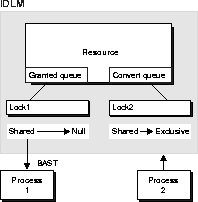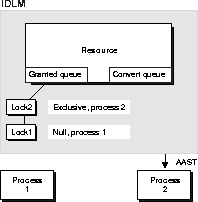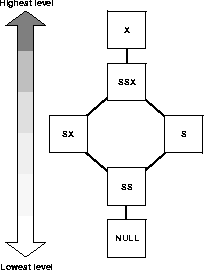Release 8.0
A58238-01
Library |
Product |
Contents |
Index |
| Oracle8 Parallel Server Concepts & Administration Release 8.0 A58238-01 |
|
This chapter explains the role of the Integrated Distributed Lock Manager (Integrated DLM, or IDLM) in controlling access to resources in a parallel server. The chapter is organized as follows:
The Integrated Distributed Lock Manager component of Oracle8 maintains a list of system resources and provides locking mechanisms to control allocation and modification of Oracle resources. IDLM resources are logical concepts, structures of data. The IDLM does not control access to tables or anything in the database itself. Every process interested in the database resource protected by the IDLM must open a lock on the resource.
Oracle Parallel Server uses the IDLM facility to coordinate concurrent access to resources, such as data blocks and rollback segments, across multiple instances. The Integrated Distributed Lock Manager facility has replaced the external Distributed Lock Manager which was used in earlier releases of Oracle.
The IDLM coordinates lock requests, ensuring compatibility of access rights to the resources. In this process the IDLM tracks all lock requests. Requests for available resources are granted and the access rights granted are tracked. Requests for resources not currently available are tracked, and access rights are granted when the resource does become available. The IDLM keeps an inventory of all these lock requests, and communicates their status to the users and processes involved.
The IDLM maintains two queues for lock requests:
To communicate the status of lock requests, the IDLM uses two types of asynchronous traps (ASTs) or interrupts:
The term "persistent resource" refers to the ability of a resource to maintain a particular state if all processes or groups holding a lock on it have died abnormally. This contrasts with normal resources, which cease to exist when there are no longer any owners of locks on that resource, regardless of how they exited.
Resource persistence is necessary for fine grain locking. It ensures that the database resources protected by these locks can be recovered correctly and efficiently.
Note: Not all resource information is kept after failures, only adequate information to protect resources during recovery.
The following figures show how the IDLM handles lock requests. In Figure 8-1, shared lock request #1 has been granted on the resource to process 1, and shared lock request#2 has been granted to process 2. The locks are tracked in the granted queue. When a request for an exclusive lock is made by process 2, it must wait in the convert queue.

As illustrated in Figure 8-2, the IDLM sends a blocking AST to Process 1, the owner of the shared lock, notifying it that a request for an exclusive lock is waiting. When the shared lock is relinquished by Process 1, it is converted to a null mode lock, or released.

An acquisition AST is then sent to wake up Process 2, the requestor of the exclusive lock. The exclusive lock is granted and it is converted to the granted queue. This is illustrated in Figure 8-3.

Locks are used to obtain various rights to a resource. A lock may be initially created on a resource with no access rights granted. Later, a process will convert a lock to obtain new access rights.
Figure 8-4 illustrates the levels of access rights or "lock modes" which are available through the IDLM.

This section describes the following features of the Integrated DLM:
The IDLM maintains a database of resources and locks held on these resources in different modes. This lock database resides in volatile memory, and is distributed. The Integrated DLM has a distributed architecture. In the distributed architecture each node in the cluster (or each Oracle Parallel Server instance of an Oracle database) participates in global lock management and manages a piece of the global lock database. The lock database is distributed among all the participants. This distributed lock management scheme provides fault tolerance and enhanced runtime performance.
The Integrated DLM is fault tolerant: it provides continual service and maintains the integrity of the lock database in the event of multiple node and Oracle Parallel Server instance failures. Instance reconfiguration may cause a brief delay. A database is accessible as long as there is at least one OPS instance that is active on that database after recovery completes. Fault tolerance also enables OPS instances to be started and stopped at any time, in any order.
In a distributed system the IDLM must maintain information about the locks on all nodes that are interested in a given resource. In this situation, the IDLM usually nominates one node to manage all relevant information about the resource and its locks. This is called the master node.
Two methods of lock mastering are currently available:
The Integrated DLM optimizes the method of lock mastering to use in each situation. The method of lock mastering has an impact on system performance, during normal runtime activity as well as during instance startup. Performance is optimized when a resource is mastered locally. When a resource is mastered remotely, all conflicting accesses to this resource result in a message to the master node for this resource, which results in internode message traffic and impacts system performance.
Associated with every resource is a directory node and a master node. The directory node is derived from the resource name (the resource name is hashed to one of the active nodes in the cluster). The directory node maintains information about the node on which a resource is mastered. The node that masters a resource is the master node for the resource. Each node acts as the directory node for a subset of resources. In this sense, the directory service is distributed across all nodes in the cluster.
IDLM performs distributed deadlock detection, in which all deadlock sensitive locks and resources can be distributed.
Oracle Parallel Server uses the fast and scalable Lamport SCN generation scheme, which can generate SCNs in parallel on all instances.
See Also: "Lamport SCN Generation" on page 4-7.
Group-based locking provides dynamic ownership: a single lock can be shared by two or more processes belonging to the same group. Processes in the same group can share and/or touch the lock without going to the IDLM grant and convert queues.
See Also: "Support for MTS and XA" on page 8-12.
The Integrated DLM provides for persistent resources. Resources maintain their state even if all processes or groups holding a lock on it have died abnormally.
See Also: "Persistent Resources Ensure Efficient Recovery" on page 8-3.
The user-level Integrated DLM can normally allocate as many resources as you request; your process size, however, will increase accordingly. This is because you are mapping the shared memory where locks and resources reside into your address space. The process address space can become very large.
Make sure that the IDLM is configured to support all the resources which your application will require.
Oracle Parallel Server uses two forms of lock ownership:
Group-based locking is an important IDLM feature for Oracle multi-threaded server (MTS) and XA library functionality.
Four dynamic performance views are available to monitor Integrated DLM statistics. These are:
See Also: Oracle8 Reference for a complete description of these dynamic performance views.